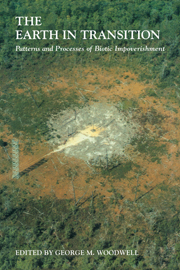Book contents
- Frontmatter
- Contents
- Preface
- Acknowledgments
- List of Contributors
- Part I Global Change and the Patterns of Impoverishment
- Part II Chronic Disturbance and Natural Ecosystems: Forests
- Part III Chronic Disturbance and Natural Ecosystems: Woodlands, Grasslands, and Tundra
- Part IV Chronic Disturbance and Natural Ecosystems: Aquatic and Emergent Ecosystems
- 18 Changes in a Red Sea Coral Community Structure: A Long-Term Case History Study
- 19 Are Deep-Sea Communities Resilient?
- 20 Species Dominance–Diversity Patterns in Oceanic Communities
- 21 Natural and Anthropogenically Imposed Limitations to Biotic Richness in Fresh Waters
- 22 Human Impacts on the South Florida Wetlands: The Everglades and Big Cypress Swamp
- 23 The Impoverishment of Aquatic Communities by Smelter Activities near Sudbury, Canada
- 24 Biotic Impoverishment: Effects of Anthropogenic Stress
- Part V Conclusion: Steps toward a World That Runs Itself
- Name Index
- Subject Index
21 - Natural and Anthropogenically Imposed Limitations to Biotic Richness in Fresh Waters
Published online by Cambridge University Press: 24 November 2009
- Frontmatter
- Contents
- Preface
- Acknowledgments
- List of Contributors
- Part I Global Change and the Patterns of Impoverishment
- Part II Chronic Disturbance and Natural Ecosystems: Forests
- Part III Chronic Disturbance and Natural Ecosystems: Woodlands, Grasslands, and Tundra
- Part IV Chronic Disturbance and Natural Ecosystems: Aquatic and Emergent Ecosystems
- 18 Changes in a Red Sea Coral Community Structure: A Long-Term Case History Study
- 19 Are Deep-Sea Communities Resilient?
- 20 Species Dominance–Diversity Patterns in Oceanic Communities
- 21 Natural and Anthropogenically Imposed Limitations to Biotic Richness in Fresh Waters
- 22 Human Impacts on the South Florida Wetlands: The Everglades and Big Cypress Swamp
- 23 The Impoverishment of Aquatic Communities by Smelter Activities near Sudbury, Canada
- 24 Biotic Impoverishment: Effects of Anthropogenic Stress
- Part V Conclusion: Steps toward a World That Runs Itself
- Name Index
- Subject Index
Summary
Editor's Note: Lakes and streams receive a disproportionate share of the disruption that follows the spread of human influences over the globe. The disruption reaches from the direct effects of dams and modifications of water courses to the disposal of sewage and the introduction of toxins including agricultural poisons. There is in addition the series of problems associated both with the depletion of the fish populations through harvest and with the introduction of exotics. And, more recently, we have recognized the seriousness of the problems associated with air pollution, including the acidification of rain and the cumulative effects on lakes. Now we see the further possibility that genetic engineers will be adding to the burdens already well known from the introduction of exotics by producing novel combinations of genes that may escape into nature to produce totally unforeseen effects.
In many ways, among all of science, the limnologists have led in defining the transitions under way in nature. The process of eutrophication was recognized first in aquatic systems and has since been recognized as a general phenomenon, the enrichment with nutrients mobilized by human activities, a first step in the continuum of change that is gradualy recognized as pollution, and, in a twist peculiar to nature, impoverishment.
The full array of effects and patterns laid forth so explicitly by Schindler is almost overwhelming. But the other message, only slightly less powerfully articulated, is that the changes are a continuum away from the status quo toward progressive impoverishment.
- Type
- Chapter
- Information
- The Earth in TransitionPatterns and Processes of Biotic Impoverishment, pp. 425 - 462Publisher: Cambridge University PressPrint publication year: 1991
- 5
- Cited by

